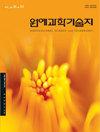模拟出口系统下辣椒品种果实品质属性和生理失调的季节差异
IF 0.8
4区 农林科学
Q3 HORTICULTURE
Korean Journal of Horticultural Science & Technology
Pub Date : 2023-08-31
DOI:10.7235/hort.20230038
引用次数: 0
摘要
本研究利用模拟出口系统,对块状和圆锥形辣椒品种果实品质属性的季节变化和生理失调发生率进行了研究。还研究了三种不同果皮颜色的影响。以‘Scirocco’、‘DSP 7054’和‘Volante’为块状型,以‘Raon red’、‘Raon orange’和‘Raon yellow’为圆锥形型,果皮颜色分别为红色、橙色和黄色。果实在10°C条件下装运两周,在10°C条件下贮存一周,然后在22°C条件下转移一周,模拟装运出口。与夏季相比,冬季的储存温度和相对湿度水平波动很大。因此,无论品种类型如何,冬季果实失重率均高于夏季。果皮硬度在冬季较低。可溶固形物含量和可滴定酸度均以圆锥形品种高于块状品种,以‘拉贡红’品种最高。根据果皮颜色和果实类型的不同,果皮亮度和色相角在出口季节有不同的反应。果实枯萎的发生率和严重程度在冬季均高于夏季,且与品种无关。无论果皮颜色如何,圆锥形型的果实萎缩程度都低于块状型。果实软化、花梗萎蔫、花梗褐变的发生率和严重程度冬季均高于夏季。因此,研究结果表明,在季节性出口期间,储存湿度水平可能对辣椒果实品质的采后处理起关键作用。因此,需要根据出口季节和特定类型的水果仔细考虑各种技术。本文章由计算机程序翻译,如有差异,请以英文原文为准。
Seasonal Difference of Fruit Quality Attributes and Physiological Disorders in Paprika Cultivars under a Simulated Export System
This study evaluated seasonal changes in various fruit quality attributes and the incidence of physiological disorders in the blocky and conical types of paprika cultivars using a simulated export system. The effects of three different pericarp colors were also investigated. ‘Scirocco’, ‘DSP 7054’, and ‘Volante’ cultivars were used as a blocky type, while ‘Raon red’, ‘Raon orange’, and ‘Raon yellow’ cultivars were used as a conical type with red, orange, and yellow pericarp color, respectively. The fruit was shipped at 10°C for two weeks, stored at 10°C for one week, and then transferred at 22°C for one week to simulate export by shipping. Storage temperatures and relative humidity levels greatly fluctuated in the winter season as compared to the summer season. Thus, fruit weight loss was higher in the winter season than in the summer season regardless of the cultivar type. However, the pericarp firmness was lower in the winter season. The soluble solids content and titratable acidity were higher in conical type than in the blocky type of paprika cultivar and highest in the ‘Raon red’ cultivar. The pericarp lightness and hue angle responded differently during the export season, depending on the pericarp color and fruit type. The incidence and severity of fruit shriveling were higher in the winter season than in the summer season, irrespective of the cultivar. Fruit shriveling was less severe in the conical type than in the blocky type, regardless of the pericarp color. Moreover, the incidence and severity of fruit softening, pedicel wilting, and pedicel browning were higher in the winter season than in the summer season. Therefore, the results indicate that the storage humidity levels likely play a pivotal role in the postharvest handling of paprika fruit quality during the seasonal export period. Thus, careful consideration of various techniques that are contingent upon the season of export and the specific type of fruit is required.
求助全文
通过发布文献求助,成功后即可免费获取论文全文。
去求助
来源期刊
CiteScore
2.00
自引率
0.00%
发文量
0
审稿时长
1 months
期刊介绍:
Horticultural Science and Technology (abbr. Hortic. Sci. Technol., herein ‘HST’; ISSN, 1226-8763), one of the two official journals of the Korean Society for Horticultural Science (KSHS), was launched in 1998 to provides scientific and professional publication on technology and sciences of horticultural area. As an international journal, HST is published in English and Korean, bimonthly on the last day of even number months, and indexed in ‘SCIE’, ‘SCOPUS’ and ‘CABI’. The HST is devoted for the publication of technical and academic papers and review articles on such arears as cultivation physiology, protected horticulture, postharvest technology, genetics and breeding, tissue culture and biotechnology, and other related to vegetables, fruit, ornamental, and herbal plants.

 求助内容:
求助内容: 应助结果提醒方式:
应助结果提醒方式:


